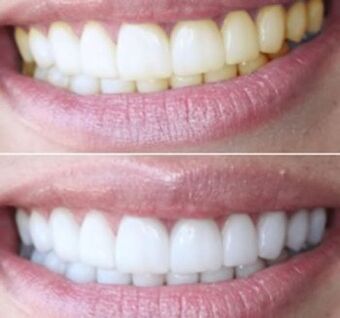Contents
Teeth whitening: indications, effectiveness, price
Bright, white teeth are synonymous with health and beauty. But diet, tobacco, healthy lifestyle, the passage of time or certain pathologies are all factors that can be conducive to yellowing and dulling of teeth. What is tooth whitening? Are there any contraindications to its practice? The answers of Dr Helali Selim, dental surgeon
Definition of tooth whitening
The purpose of tooth whitening is to remove the dyes located under the enamel of the tooth, in order to obtain clearer teeth. “This modifies the saturation and the luminosity, but the hue, the degree of transparency and opacity remain unchanged. This is the reason why we should use the term “clarification” and not “whitening” “corrects Dr Helali.
There are different lightening treatments, all of which are the result of a chemical oxidation-reduction reaction between the coloring pigments present on the teeth and the bleaching molecule.
Teeth whitening: for whom?
Teeth whitening is for people whose teeth have undergone staining or have lost brightness for various reasons such as:
- the lifestyle ;
- various pathologies;
- hereditary factors.
The simplest cases
“The simplest cases consist of a readjustment of the natural shade of the teeth, a treatment of colorations due to aging or a treatment of the lack of brightness of the teeth.”
The most complicated cases
“More complicated cases of intrinsic dyschromia – linked to a congenital disorder – can also benefit from clarifications in addition to other therapies” specifies the specialist.
Indication and caution with tooth whitening
Be careful, however: lightening is not a trivial practice, insists Dr Helali “we must remain vigilant and set out its indication because if the lightening is practiced in an abusive or uncontrolled way, it can lead to irreversible damage, such as that dentinal hypersensitivity, alteration and weakening of the enamel… ”.
Types of bleaching
Two dental whitening techniques are now mainly practiced in an office.
The outpatient technique
Custom-made transparent aligners are made for the patient in the office. Back home, he places a lightening gel in it and wears it for one to two hours a day. “The aligners are made of flexible polyvinyl and the lightening gel is carbamide peroxide in the form of a 10 to 16% gel” specifies the specialist “the port is done for several weeks until the desired lightening is obtained, under the control of the practitioner “
The technique in the practice
The oxidizing agent used in the office is much more concentrated than that offered in an outpatient setting. After taking care to protect the gums and mucous membranes, the dentist places the oxidizing agent directly on the patient’s teeth.
“Most often, intense blue light is also applied to the product to accelerate the oxidation reaction” specifies the dentist. The lightening session lasts between an hour and an hour and a half and begins with a complete clinical examination with x-rays and initial photos, scaling and polishing of the teeth.
The lightening product is applied in intervals of 15 minutes depending on the desired result. “This technique allows faster results to be obtained, but it may be less comfortable than the outpatient technique, depending on the sensitivity of the patient,” says Dr Helali.
For more severe cases, the combination of the two techniques is very often recommended.
Teeth whitening results
The results of tooth whitening depend on the nature of the patient’s teeth, their health, their quality and the technique used. This is the reason why any tooth whitening must be preceded by a clinical examination. “This preliminary examination allows the practitioner to highlight the advantages, risks and chances of success of the proposed treatment and therefore to validate the indication” explains the specialist.
Followed by the evolution
At the end of the examination, dental photographs are taken to follow the evolution of the shade and the effectiveness of the product on the tooth enamel. “This last step allows us to measure the patient’s sensitivity to the treatment, which differs from one person to another,” explains Dr Helali.
Identify the cause of dyschromia
Finally, it is necessary to determine the cause and the origin of the dyschromia: “It is important to precisely define the origin of the coloration, its type, its shape and its degree to predict the effectiveness of the treatment because there are many causes. of dyschromia for which the clarification will mask the pathology without solving the problem ”.
Using software to simulate the result
Today software can simulate the final result before treatment in order to help the patient in his decision-making.
Contraindications to tooth whitening
As the dentist explains, there are several formal contraindications to performing tooth whitening:
- Teeth with significant alterations, reconstructions or caries;
- During orthodontic treatments;
- In the presence of excessive dental sensitivities;
- In certain general pathologies.
The other contraindications:
Other contraindications are relative, to be studied on a case by case basis with each patient:
- Pregnant or breastfeeding women;
- Patients with poor hygiene;
- Patients with periodontal disease.
- The patient with known sensitivities / allergies to the active ingredients,
- Minor patients: the contraindication is then legal;
- Children under the age of 15, whose teeth have not reached full maturity,
- Hardcore smokers.
In addition, lightening does not solve all the problems related to the color of the teeth. “In cases of severe dyschromia (especially related to fluorosis or tetracyclines), lightening alone does not allow us to have satisfactory results” insists the specialist.
Price and reimbursement of teeth whitening
The lightening is a personalized treatment, which differs very widely from one person to another depending on the technique used and the number of sessions. The price is therefore very variable and can vary between 600 and 1500 euros.
This treatment is considered aesthetic and is therefore not covered by social security.










